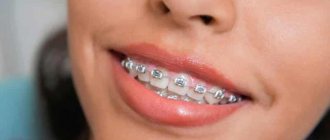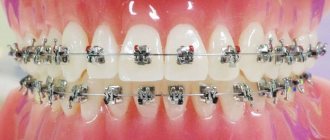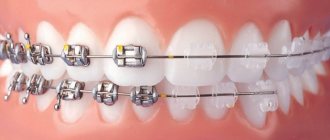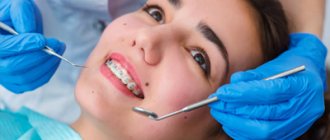If you think you've missed the boat, don't worry. Modern orthodontics allows you to correct your bite at any age, even if you are over 18. One of the brace systems that help create an ideal smile, H4, was developed by the American company OrthoClassic.
Here is a self-ligating design that is suitable for both teenagers and adults. There are no ligatures, which means you won’t have to visit the orthodontist often. Using clip-locks, they are attached directly to the teeth, and a metal arc is threaded through them, with which you can adjust the tension.
H4 are proven systems that will be an excellent solution for various malocclusions.
What are H4 braces?
The structures are manufactured by the famous American company Ortho Classic. The bracket system consists of a forming arch and braces. The arch is necessary to create the contour of an ideal smile and is secured using special locks.
The system is based on self-ligating (blocking) staples to hold the arc. No more rubber bands or wires! This minimizes the pain of treatment and the likelihood of side effects.
In fact, there is no other product that can treat bites so elegantly. Self-ligating H4 braces are smaller than other systems and move teeth with light pressure and low friction. As a result, they are more comfortable for the patient and provide faster results than typically achieved with braces.
Orthodontist at the Stimul clinic Olga Vladimirovna Pavlyukova
How does the braces system work?
Braces are designed to correct malocclusions.
The design consists of two basic components: bracket plates that are attached to the teeth, and a power arch that exerts force pressure on the elements of the dentition. In non-ligature designs, which include the H4 system, the arc is attached to the plates using miniature locks. (For reference: in ligatures, the fasteners are rubber rings or steel wires). The mechanism of the therapeutic effect of braces is quite simple:
- the material from which orthodontic arches are made has shape memory, that is, if this product is bent, it tends to straighten to its original position. During the straightening process, the arc begins to pull the teeth along with it. Its form is individual for each clinical situation;
- bone tissue is absorbed in the direction of movement (the phenomenon is called resorption). And where a void has formed from a displaced dental element, on the contrary, it begins to grow.
During treatment, the orthodontist regularly adjusts the device, this ensures continuity of the process. At the very beginning, flexible circular arcs with a diameter smaller than the groove are used. After the initial movement of the teeth, square ones are used (more rigid), and at the final stage, rectangular ones are used, which completely fill the grooves of the clasps and firmly fix the position of the dental units in the new place.
Preparation and installation process
Preparations for treatment begin after the dentist has confirmed the need to install braces. The first step is to cure diseased teeth and gums, if any.
The further work algorithm includes the following procedures:
- panoramic photograph of the oral cavity;
- photographs of the face and teeth;
- making impressions of the dentition;
- articulation study.
If necessary, patients are given consultations with related specialists: a surgeon or an implantologist.
On the appointed day, the patient must first eat a hearty meal. The installation process occurs using a direct or indirect method. Each bracket can be glued to each tooth separately, or the entire structure can be installed through aligners .
The installation itself takes at least an hour and a half. It is painless and does not require anesthesia.
- Professional oral hygiene is performed.
- The enamel is treated with a protective compound.
- Primer and special glue are applied.
- The braces are fixed and excess glue is removed.
- The result is recorded under a light lamp.
Rules for hygienic care and equipment for its implementation
Clean braces and teeth are the key to a healthy mouth after treatment.
Dentists recommend brushing your system and teeth in the morning and evening, as well as every time after eating. If complete cleansing is not possible after eating, be sure to thoroughly rinse your mouth with water. For quality cleaning, a toothbrush alone is not enough. What you need to have on hand:
- orthodontic V-shaped brush. This shape allows you to more thoroughly clean the space around the braces;
- brushes with different angles of inclination of the working part. With their help you need to clean the parts of the bracket structure;
- dental floss - super-floss, which has different thicknesses along the length for more effective cleaning;
- irrigator is a device that performs cleaning with a directed stream of water or medicinal solution. With its help you can clean the most inaccessible places in the structure;
- fluoride-containing pastes and rinses.
Note: even the highest quality self-hygienic care cannot replace the work of a specialist using special devices. Therefore, during treatment, it is recommended to visit the clinic for professional care once every 2-3 months.
Duration of treatment with H4 braces
The duration depends on the initial position of the teeth. The average duration of wearing the systems is a year. Thanks to more precise tooth movement, treatment times with this system are 25% shorter than traditional structures.
Often patients want to give up braces after six months, as the first results have become noticeable. However, a retention period must pass when the skeletal system adapts to new conditions. Take your time, listen to the doctor and your perfect smile will stay with you for life.
It is important to carry out professional oral cleaning in a timely manner and under the supervision of a specialist. There is a high risk of bacterial growth under structural parts.
Is a retention period required?
The retention stage (consolidation of the result) is extremely important. Without it, the teeth will return to their original position, because the newly formed bone tissue is not yet strong enough. The reverse process without a retention period will occur much faster than the directed displacement of dental units. Moreover, the situation may become much worse than it was before therapy.
The duration of retention is determined by the attending orthodontist, based on observations of the patient and his age. The older the person, the longer the period of correction and consolidation of the effect.
Advantages of H4 braces
The positive points include:
- In 95% of cases, you can do without tooth extraction.
- Shorter treatment period. In about half of the cases, the duration can be halved!
- Comfortable to wear. Thanks to the smaller size of the braces, the adjustment time is reduced to 3-5 days. And even long-term wearing becomes more comfortable.
- Perfect result. Thanks to the protocols and technical configuration, you will not get this result with any other system.
Expert advice
- Do not delay starting treatment. The younger the patient, the faster the correction process occurs.
- Do not stop the course of therapy you have started, even if you are satisfied with the results achieved. Only a doctor can determine exactly how long it takes to complete the process.
- Follow your dentist's dietary and hygiene recommendations.
The dental network offers services for correcting occlusion defects with H4 metal non-ligature braces. We provide payment in installments for orthodontic treatment and arrange medical treatment. documents for personal income tax deduction.
Our specialists are highly qualified and improve their professional level in leading dental clinics in Russia and Europe.
The clinic's branches are located in Moscow within walking distance from the metro:
- Art. Alekseevskaya (VDNKh district, etc. Mira), address: st. 3rd Mytishchiskaya house 3, building 2;
- Art. Shelepikha, address: Shelepikhinskaya embankment, address: building 34, building 1.
A beautiful smile without discomfort is real. Come to our clinic and see for yourself!
Question answer
- Are there any contraindications for wearing braces?
This is an additional load on the dental system. For certain conditions and chronic diseases, they can only worsen the situation. The list of contraindications includes: oncology, tuberculosis, diabetes mellitus, anomalies in the development of the skeletal system, neuropsychiatric diagnoses.
- Is it possible to get braces at 40-50 years old?
Braces can be installed at any age, but it will take more time to achieve a positive result. The reason is slow metabolic processes and a stop in the growth of bone tissue. Often older patients have to undergo surgery. The tooth may not have enough space in the jaw arch for proper fixation. To free it, the adjacent tooth is removed.
- Does braces damage enamel?
The braces are attached with glue. It does not have a negative effect on the enamel, and even protects it. However, deposits in the form of white spots gradually accumulate around. They cause tooth decay. To avoid this problem, it is only important to visit a doctor in a timely manner and undergo professional hygienic cleaning.
- Is it necessary to remove wisdom teeth before installing braces?
There is a popular opinion that before installing braces, “figure eights” must be eliminated. In fact, this statement is not entirely correct. Wisdom teeth are not always removed, but only when absolutely necessary. As a preventive measure, removing them is not only wrong, but also dangerous.
Indications and contraindications
Braces therapy is performed if there are certain medical indications. Treatment can be started only if there are no contraindications. The orthodontist identifies all these aspects before planning a correction course.
Indications:
- Uneven position of dental elements in a row
- Crowding
- Displacement of the jaws relative to each other
- Abnormal interdental spaces (diastemas and trema)
- The need for dentures in case of dentition after tooth extraction
- Other occlusion defects
Contraindications:
- AIDS, HIV, tuberculosis
- Oncology
- Diabetes mellitus and thyroid dysfunction
- Severe problems with the cardiovascular system
- Bone diseases
- Blood diseases
- Children's age up to 12 years
- Lack of teeth for support
Flaws
Despite their compact size, many customers are confused by the appearance of metal devices. Due to the lack of aesthetics, such designs are avoided - after all, they will have to be worn for a long time, about 2 years or even more.
Although ligature-free constructions cause such problems to a lesser extent, the patient’s tooth enamel may still be damaged after wear.
In addition, various complications may arise during the correction process - any brace system is not without this feature.
Design Features
- Self-ligating H4 braces have a low profile, and their small size has a positive effect on wearing comfort.
- The edges of each microelement of the structure are smoothed and polished, which reduces the risk of injury to the mucous membrane to zero, reduces the amount of bacterial plaque and makes it easier to clean the braces.
- The material of the braces has a high degree of smoothness, so the arch slides in the grooves with minimal friction and stress.
- The braces area has an anatomical shape and a special Treadlok adhesive base with microscopic channels for better distribution of dental glue, which allows them to be fixed to the teeth absolutely hermetically.
- Due to the high strength of attachment of H4 braces to the teeth and the reliability of the material itself, it is unlikely that any structural element will be broken.
The manufacturer claims that H4 braces do an excellent job with any bite problems.
Types of self-ligating braces
Liature-free braces are divided into types according to their mechanism of action, material of manufacture and brands of individual manufacturers (brands).
By mechanism of action
Based on this feature, ligature-free braces are divided into two types:
- active – the cap (clip) exerts active pressure on the arc, forcing it to move in the desired direction;
- passive - the lid does not affect the arc in any way, it simply holds it in the lock; it is believed that this is a more natural type of correction that does not injure the periodontal tissues.
By material
Metal and ceramic self-ligating systems
Self-ligating braces are made from metal, dental ceramics and artificial sapphires. The strength and volume of the model, as well as indications for its use and aesthetics, depend on the material of manufacture.
Metal self-ligating braces
The most popular and reliable non-ligature models. Advantages:
- durable, reliable bracket systems, do not break, suitable for correcting any anomalies;
- easy to install and remove;
- cheaper than models made from other materials.
The disadvantages of metal structures include their low aesthetics: metal braces, even with the smallest locks, will always be visible when you smile.
Ceramic self-ligating braces
Also popular models are made of durable white dental ceramics in different shades. They are installed by patients who want to look more aesthetically pleasing. Advantages of metal self-ligating bracket systems:
- lighter and more comfortable to wear;
- you can choose the color of the locks exactly to match the color of your own teeth and they will be invisible, since they do not give glare;
- the adaptation period passes quickly, there is practically no discomfort or speech impairment;
- do not injure the soft tissues of the oral cavity.
Disadvantages of ceramic structures:
- more fragile compared to metal ones, sometimes they break and are not used for the correction of complex malocclusions;
- more expensive than metal ones;
- the metal arc is still visible when you smile.
Sapphire self-ligating braces
Made from transparent artificial sapphires, characterized by high strength and brilliance. Advantages:
- aesthetics - the reflection of light makes the metal arch less noticeable and gives the smile a radiance;
- stronger than ceramic ones, but inferior in strength to metal ones; therefore, they are used to correct some complex malocclusions, but still not all;
- do not have a negative effect on surrounding tissues.
Disadvantages of sapphire models:
- require more careful care, as they can quickly lose transparency due to plaque;
- the most expensive.
By brand
Global manufacturers are constantly improving their models and brand lines. Externally similar designs can differ significantly in their properties and correction efficiency. Below you can find the most popular brands of self-ligating braces.
Self-ligating Damon braces (Ormco, USA)
The Damon line of self-ligating braces is the most popular in our country. The designs are easy to use and reliable due to improved valves with locks, allowing you to quickly install and remove the system. Popular Damon (Daimon) models:
- Damon Q self-ligating braces - a comfortable and ultra-reliable design made from a hypoallergenic metal alloy, is very popular among orthodontists and their patients. A passive type of traction is used, which allows you to cope with any anomalies of the dentition in a shorter time compared to other systems. Small clasps help patients quickly adapt and do not cause them discomfort when wearing braces. The model costs a lot, but is cheaper than designs made from other materials;
- Damon Clear are aesthetic ceramic braces made of highly wear-resistant material based on aluminum. The improved locking shutter allows for quick installation and removal of the system. The model is reliable, but less durable than metal structures, so it is not used to correct complex malocclusions, and it is also very expensive.
Damon Q braces
Damon Clear braces
Clarity SL (3M Unitek, USA)
The company is a leader in the production of bracket systems: the Clarity SL model of self-ligating ceramic braces successfully competes with Damon Clear. Increased reliability of the design is provided by the use of metal to strengthen the channels (the arc passes through them) in the locks. The model is aesthetic and almost invisible on the teeth, but is not intended for the correction of complex anomalies. But its price is lower than that of Damon Clear.
Clarity SL braces
Experiense (GC Orthodontics, Germany)
German products are traditionally of high quality. Experience metal – self-ligating braces of high reliability due to clasps made of ultra-strong, non-oxidizing metal. They are cheaper than the Damon Q system, but are in no way inferior to it in quality, and are used to correct malocclusions of any complexity.
In Ovation (Dentsply, USA)
The In Ovation (Innovation) line from the American company Dentsply is also distinguished by its aesthetics and reliability. It includes models:
- In Ovation R are metal self-ligating braces with a special locking design that allows you to set the desired arch tension and distance between the locks. The design is very reliable and can be used to treat complex malocclusions;
- In Ovation C is a ceramic aesthetic model. The clasps are coated with zirconium dioxide to prevent discoloration. The design features of the model prevent its incorrect installation. These are high quality braces and are cheaper than Damon Clear.
In Ovation R braces
Self-ligating brackets H4 (Ortho Classic, USA)
H4 are high quality metal self-ligating braces made from fully biocompatible metal. Their special feature is the miniature clasps, located as close as possible to the gums, so that the h4 system is practically invisible when smiling. The system is comfortable to wear and does not irritate soft tissues.
H4 braces
Brand lines of Forestadent, Germany
The oldest German company presents a line of four self-ligating models:
- QuicKlear is a self-regulating ceramic design. A special feature is a metal flap with clasps for threading the arc. The flap is polished, has a matte color and almost does not differ from the locks in color, the locks are flat, their edges are rounded. They actively influence the arc, ensuring its movement in the desired direction. This is a reliable and beautiful model;
- TruKlear is an improved version, a ceramic self-ligating model with a ceramic lid. Special ceramics do not change its color, which is why the design is almost invisible on the teeth;
- BioQuick – active self-ligating ceramic braces with small clasps. A special feature of the design is the quick fixation of the locks with special protrusions on their base. The force holding the arc in the groove allows it to be moved in the desired direction;
- BioPassive – passive self-ligating ceramic braces. Passive action is achieved through a flexible cap and deep grooves that reduce arc friction. Effective correction is combined with a soft, non-traumatic effect on periodontal tissues.
How much does it cost to install ligature-free braces?
The cost of installing self-ligating braces consists of:
- cost of examination and preliminary treatment;
- the orthodontist’s work on installing the structure;
- prices of braces depending on the brand;
- geographic location and reputation of the clinic.
Approximate prices for different brands of non-ligature braces for one jaw:
- Damon Q: 27–50 thousand rubles.
- Damon Clear: from 60 thousand rubles.
- In-Ovation R: 40 thousand rubles.
- In-Ovation C: from 45 thousand rubles.
- Activation of a self-ligating brace system from RUB 2,800.
Advantages and disadvantages of non-ligature systems
Self-ligating non-ligature braces have a number of advantages over classic ligature braces. They:
- thinner, more elegant, less noticeable;
- provide easier adaptation of the patient to them;
- are installed quickly, since there is no need to attach the arc separately to each lock, it is simply threaded through the caps;
- allow precise adjustment of the system taking into account the required trajectory;
- do not require frequent correction: you need to visit the orthodontist no more than once every two months, whereas after installing ligature braces - once a month or even more often;
- physiological, do not have a negative effect on periodontal tissues;
- reduce the duration of correction;
- do not require much maintenance effort compared to ligature ones (food debris gets stuck mainly in the ligatures).
The disadvantage of non-ligature self-ligating braces is their higher price compared to ligature ones.
A little about the manufacturer
H4 braces are manufactured by the large American company OC Orthodontics. The association has conquered the global market for dental products thanks to high quality, the use of innovative technologies and affordable prices for its products.
The company is distinguished by a wide product distribution network and close cooperation with specialists all over the world.
In the USA, OC Orthodontics regularly trains dentists and orthodontists, disseminating skills in handling new technologies and introducing samples of its products.
This is an extensive association of specialists, not only implementing production, but also engaged in innovation activities.











